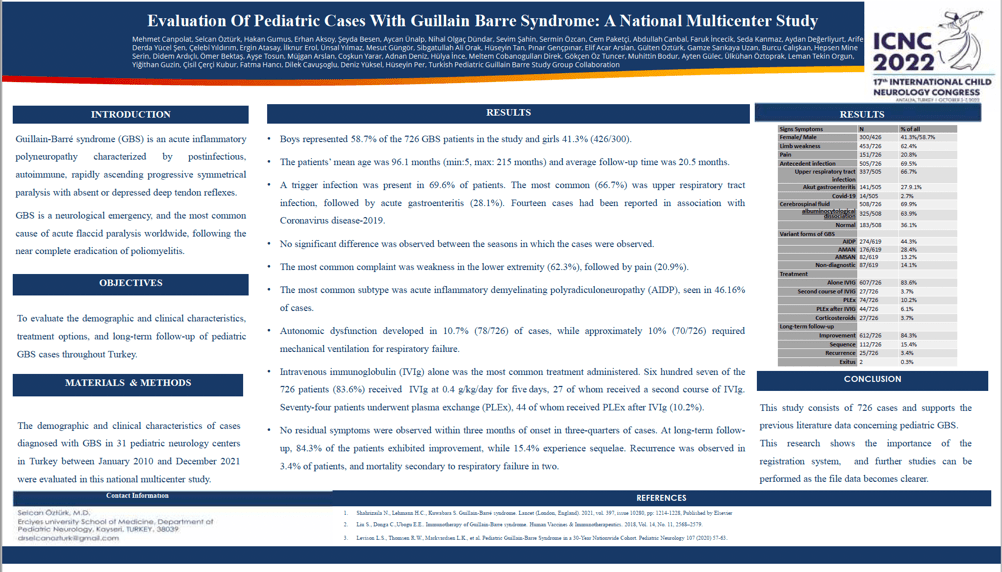Evaluation Of Pediatric Cases With Gullian Barre Syndrome: A National Multicenter Study
Mehmet Canpolat, Selcan Öztürk, Hakan Gumus, Erhan Aksoy, Şeyda Besen, Aycan Ünalp, Nihal Olgaç Dündar, Sevim Şahin, Sermin Özcan, Cem Paketçi, Abdullah Canbal, Faruk İncecik, Seda Kanmaz, Aydan Değerliyurt, Arife Derda Yücel Şen, Çelebi Yıldırım, Ergin Atasay, İlknur Erol, Ünsal Yılmaz, Mesut Güngör, Sibgatullah Ali Orak, Hüseyin Tan, Pınar Gençpınar, Elif Acar Arslan, Gülten Öztürk, Gamze Sarıkaya Uzan, Burcu Calışkan, Hepsen Mine Serin, Didem Ardıçlı, Ömer Bektaş, Ayşe Tosun, Müjgan Arslan, Coşkun Yarar, Adnan Deniz, Hülya İnce, Meltem Cobanogulları Direk, Gökçen Öz Tuncer, Muhittin Bodur, Ayten Gülec, Ülkühan Öztoprak, Leman Tekin Orgun, Yiğithan Guzin, Çisil Çerçi Kubur, Fatma Hancı, Dilek Cavuşoglu, Deniz Yüksel, Hüseyin Per, Turkish Pediatric Guillain Barre Study Group Collaboration
Objectives: Guillain-Barré syndrome (GBS) is an acute inflammatory polyneuropathy characterized by postinfectious, autoimmune, rapidly ascending progressive symmetrical paralysis with areflexia/hyporeflexia. This study aimed to evaluate the demographic and clinical characteristics, treatment options, and long-term follow-up of GBS cases in childhood throughout Turkey. Methods: In this national multicenter study, the demographic and clinical characteristics of the cases diagnosed with GBS in 31 pediatric neurology centers in Turkey between January 2010 and December 2021 were evaluated. Results: Of the seven hundred twenty-six GBS patients included in the study, 58.7% were a boy, and 41.3% were a girl. The mean age was 96.5 months. The patients were followed up for an average of 21.8 months. No significant difference was observed between the seasons in which they were seen. There was a trigger infection in 69.6% of the patients. The most common infection was (47.4%) the upper respiratory tract infection, and 20.2% was acute gastroenteritis. The most common complaint was weakness in the lower extremity. The most common subtype was acute inflammatory demyelinating polyradiculoneuropathy (AIDP) in 46.16%. Alone Intravenous immunoglobulin (IVIg) was the most common treatment (87.6%), followed by a combination of Plasma Exchange (PE) with IVIg (10.7%). Complete recovery was observed in 84.3% of the patients, and relapse was observed in 3.4% of them. Sequelae were seen in 15.4% of the patients. Conclusion: GBS is the most common cause of severe, acute weakness in childhood. This study has shown how important early diagnosis and appropriate treatment are for neurological prognosis.
Keywords: Guillain-Barré syndrome, weakness, acute inflammatory demyelinating polyradiculoneuropathy, child
Mehmet Canpolat
Erciyes University Faculty of Medicine, Department of Pediatric Neurology
Selcan Öztürk
Erciyes University Faculty of Medicine, Department of Pediatric Neurology
Hakan Gumus
Erciyes University Faculty of Medicine, Department of Pediatric Neurology
Erhan Aksoy
Şeyda Besen
Baskent University Adana Dr. Turgut Noyan Application and Research Center
Aycan Ünalp
University of Health Sciences, Dr. Behçet Uz Pediatric Diseases and Surgery Training and Research Hospital, Department of Pediatric Neurology
et al
Objectives: Guillain-Barré syndrome (GBS) is an acute inflammatory polyneuropathy characterized by postinfectious, autoimmune, rapidly ascending progressive symmetrical paralysis with areflexia/hyporeflexia. This study aimed to evaluate the demographic and clinical characteristics, treatment options, and long-term follow-up of GBS cases in childhood throughout Turkey. Methods: In this national multicenter study, the demographic and clinical characteristics of the cases diagnosed with GBS in 31 pediatric neurology centers in Turkey between January 2010 and December 2021 were evaluated. Results: Of the seven hundred twenty-six GBS patients included in the study, 58.7% were a boy, and 41.3% were a girl. The mean age was 96.5 months. The patients were followed up for an average of 21.8 months. No significant difference was observed between the seasons in which they were seen. There was a trigger infection in 69.6% of the patients. The most common infection was (47.4%) the upper respiratory tract infection, and 20.2% was acute gastroenteritis. The most common complaint was weakness in the lower extremity. The most common subtype was acute inflammatory demyelinating polyradiculoneuropathy (AIDP) in 46.16%. Alone Intravenous immunoglobulin (IVIg) was the most common treatment (87.6%), followed by a combination of Plasma Exchange (PE) with IVIg (10.7%). Complete recovery was observed in 84.3% of the patients, and relapse was observed in 3.4% of them. Sequelae were seen in 15.4% of the patients. Conclusion: GBS is the most common cause of severe, acute weakness in childhood. This study has shown how important early diagnosis and appropriate treatment are for neurological prognosis.
Keywords: Guillain-Barré syndrome, weakness, acute inflammatory demyelinating polyradiculoneuropathy, child
Mehmet Canpolat
Erciyes University Faculty of Medicine, Department of Pediatric Neurology
Selcan Öztürk
Erciyes University Faculty of Medicine, Department of Pediatric Neurology
Hakan Gumus
Erciyes University Faculty of Medicine, Department of Pediatric Neurology
Erhan Aksoy
Şeyda Besen
Baskent University Adana Dr. Turgut Noyan Application and Research Center
Aycan Ünalp
University of Health Sciences, Dr. Behçet Uz Pediatric Diseases and Surgery Training and Research Hospital, Department of Pediatric Neurology
et al

Selcan Öztürk
Erciyes University Faculty of Medicine,
Department of Pediatric Neurology
Erciyes University Faculty of Medicine,
Department of Pediatric Neurology